In the collective imagination, the gory depiction of certain scenes in the works of Artemisia Gentileschi (Rome, 1593 Naples, 1653) can be traced back to an episode in the artist’s life: the assault and rape by Agostino Tassi (Rome, 1578 1644). The latter was a painter, a colleague of Artemisia’s father, Orazio Gentileschi (Pisa, 1563 London, 1639), who habitually frequented the artists’ house and who, on a day in May 1611, forced his way into Artemisia’s room, taking advantage of Orazio’s absence, and while she was intent on painting at her easel, raped her. Several trials ensued. Artemisia, who was just seventeen years old at the time, had made her deposition: the assault resulting in the loss of her virginity and the attack on her family’s honor certainly had marked her deeply. In the spring of 1612 Orazio wrote a plea to the papal court in which he accused Tassi of raping his daughter. The latter had promised Artemisia to make her his wife, but he was already married and so the marriage was not possible. The incident had ended with Agostino being sentenced to exile, but he had in fact never served the sentence: the judge had put him at a crossroads, namely either five years of hard labor or banishment from Rome; he chose banishment, but he remained in Rome until April 1613, when he managed to have the sentence overturned.
The terrible rape was the cause of reckless simplistic schemes that spilled over into the painter’s entire artistic activity: her art was considered to be completely imbued with her biography, i.e., what Artemisia depicted in scenes dense with violence became a kind of autobiography. And again: in the 1970s, Artemisia became an emblem of feminist claims, for although she had to endure not only the immediate suffering and tragic nature of the deed, but also all the consequences in terms of trials and attacks on her honor, she established herself artistically, becoming one of the most celebrated women artists of all time (at the time Artemisia lived, the majority of established artists were men) and also made herself independent not only as a woman, but also as a daughter, as her success was due solely to her artistic abilities and her thematic and pictorial choices. She followed her ideas, breaking away from her father, already a famous painter, especially with her move to Florence.
Recent studies, which have flowed excellently into the exhibition Artemisia Gentileschi and Her Time held last year at Palazzo Braschi in Rome, have shifted the focus to the context and years contemporary with the painter, as well as to the preponderance of themes depicted by artists of her contemporaries, underscoring the departure from the usual interpretation of Artemisia’s art. The principle on which the aforementioned Roman exhibition was based is an attempt to eliminate the prejudices related to the rape carried out by Tassi and the subsequent autobiographical and feminist theories, demonstrating that Artemisia herself had been able to overcome the vicissitudes related to the violence she had suffered with some speed, and that those violent scenes that had given rise to such theories depicted themes and subjects that were very recurrent in the works of artists contemporary to her and thus fell within the historical-artistic context within which Artemisia worked.
Already Caravaggio (Milan, 1571 Port Hercules, 1610) in about 1602 had depicted Judith cutting off the head of Holofernes, a painting now housed in the Galleria Nazionale d’Arte Antica at Palazzo Barberini in Rome. Here Michelangelo Merisi achieved an extraordinary level of realism such that the viewer is impressed. Indeed, the latter cannot help but notice the rawness of the scene depicted, the focus of which lies precisely in the cut that Judith causes on Holofernes’ throat, and from which a trail of blood vehemently splashes out, inevitably staining the white sheet on which the man lays. And the viewer also senses the now futile scream of Holofernes, who with eyes wide open and head backwards is piercing to death. The sword held forcefully in Judith’s right hand appears cruelly now stuck in the gash in the throat caused by the maiden, who with her left hand is grasping Holofernes’ hair pulling it toward herself. The girl’s gaze seems concentrated in the bloody act and seems almost jarring with the scene: indeed, it seems antithetical that such a beautiful maiden could perform this bloody deed. The gushing blood is also captured chromatically in the soft drapery that in the scene appears to descend from above right above the man. The grotesque scene depicted is in total harmony with the profile of the old woman, thehandmaid Abra, who stands next to the maiden: a grotesque, frowning profile that foreshadows the scene that, as in a tale, continues in the left side of the painting. In fact, the latter for the particular compositional choice reads horizontally from right to left, from the old woman’s grotesque gaze to the last scream that Holofernes lets out before he dies; in the middle the heroine Judith who implements the premeditated choice.
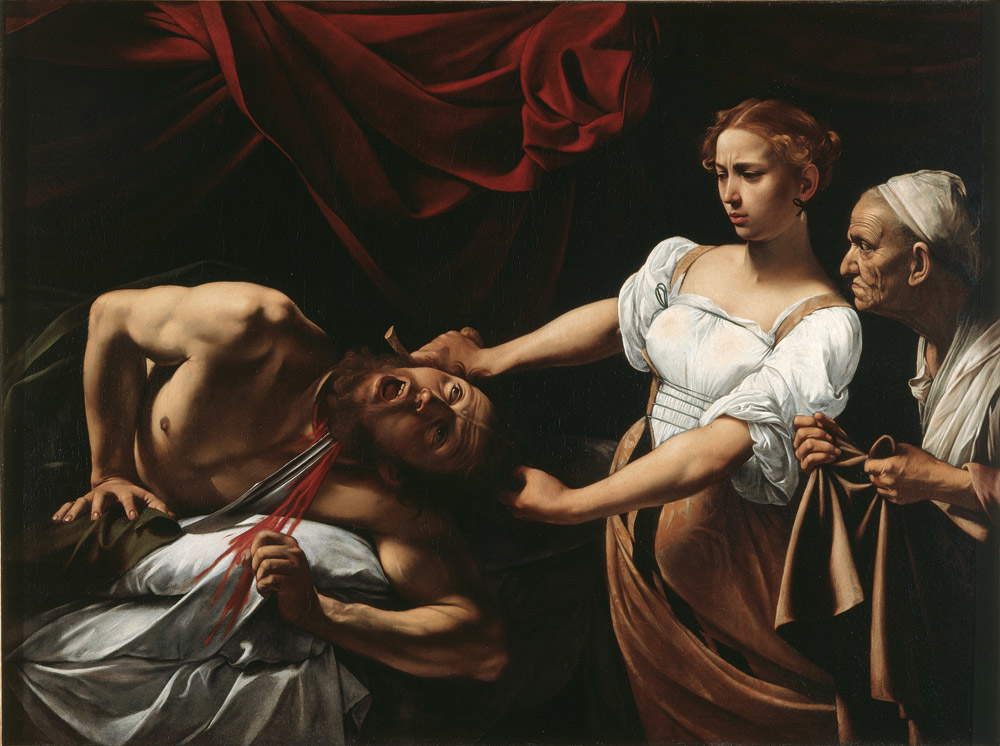 |
| Caravaggio, Judith and Holofernes (1602; oil on canvas, 145 x 195 cm; Rome, Gallerie Nazionali dArte Antica di Roma, Palazzo Barberini; Photo by Mauro Coen) |
The story of Judith and Holofernes is well known and is told in the Bible: during the reign of Nebuchadnezzar, Judith, a beautiful, wealthy, widowed maiden and inhabitant of Bethulia, the city placed under siege for a long time by the Assyrian general Holofernes, decides to save her city before the latter surrenders to complete submission. One night the girl dresses elegantly and accompanied by an old servant girl passes through enemy territory, pretending to betray her fellow citizens. Holofernes falls into the trap and welcomes her well, also convinced that he can possess her. He invites her to a banquet and gets drunk on wine: Judith then breaks into his tent with the maidservant and with two blows of the sword bravely takes off his head. She subsequently wraps it in a cloth and brings it on display to her people. This, comforted by the success of the gesture, defeats the Assyrians who were shocked by the death of their general.
Caravaggio had depicted in his famous painting a moving scene, the very moment of the killing. Orazio Gentileschi, Artemisia’s father, depicted Judith with her handmaiden in the moment after the killing, when already the severed head of Holofernes lies in the basket, still to be covered with the white cloth that can be glimpsed dangling from it. The painting dates from five years after Caravaggio’s painting, between about 1607 and 1608, and is now in the Nasjonalmuseet for Kunst in Oslo. The scene depicted appears nonviolent in the eyes of the viewer, as the bloody act has already been performed. Against a background of dark green drapery, the beautiful Judith, clad in an elegant carmine-red dress embellished with fine decorations and holding in her right hand the sword with which she cut off the Assyrian general’s head, and her trusty handmaiden Abra, who unlike the one depicted by Caravaggio is young, are in the foreground. The latter has her back turned, wears an ochre-colored dress with blue sleeves, and her head is wrapped in a long, rough, frayed white turban that falls down her back; on her left side she holds the basket with Holofernes’ head with both hands. Both young women presumably have their gaze turned toward the exit of the tent within which the gesture took place and are illuminated by a delicate light that sets them apart from their surroundings.
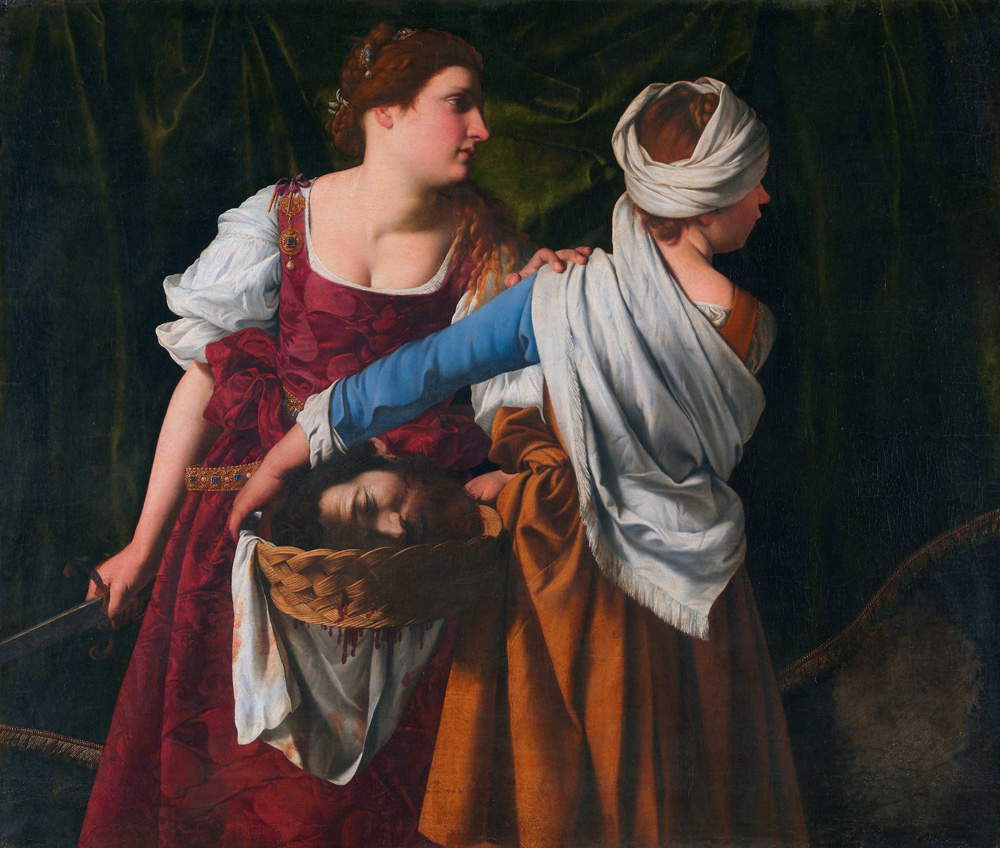 |
| Orazio Gentileschi, Judith with her Handmaid (c. 1607-1608; oil on canvas, 136 x 160 cm; Oslo, Nasjonalmuseet) |
Later, in about 1613, Artemisia depicted the same scene depicted by her father in the Oslo painting, but with greater tension: the two maidens appear much closer together and the framing is more in the foreground than in the previous one; the surroundings are undefined, only Judith and her maiden Abra occupy the scene entirely. The bloody act has now been accomplished, but one still captures the tension of the moment: Judith determinedly and in victory lays her sword on her shoulder, while with her left hand she clutches the shoulder of her maiden, depicted again from the back. Also in this painting, now preserved in the Pitti Palace in Florence, the gaze of both is turned away from the basket with Holofernes’ head. One fully captures Judith’s determination and authority in her face, still flushed from the excitement of the moment and also from the danger of being seen by her enemies. This makes the painting engaging to a greater degree than Horace’s.
One detail to note is the white cloth that comes out of the basket profusely stained with blood: red drops have even soiled the wicker basket itself. Again, the difference between Judith and her maid Abra is accentuated by the quality of the clothes: richer, ornate and elegant that of Judith, darker in color, simpler that of Abra. The latter wears a turban draped over her head that falls less broadly on her back than in Horace’s work, while Judith’s wealth is evidenced even more by the precious hairpin that gathers a sort of braid in her hair and the hilt of her sword decorated with the face of a screaming mask. The two appear illuminated by a beam of light that further sets them apart from the entire scene.
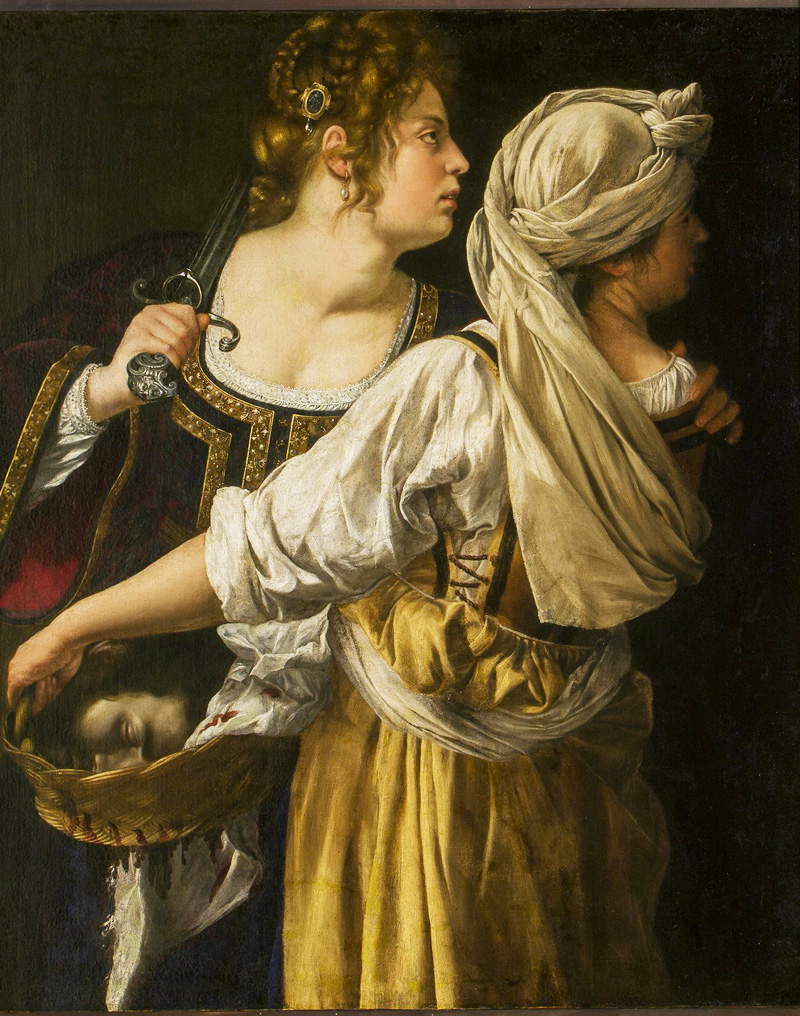 |
| Artemisia Gentileschi, Judith and the Maid Abra (c. 1613; oil on canvas, 114 x 93.5 cm; Florence, Palazzo Pitti, Galleria Palatina) |
The two paintings in Oslo and the Palazzo Pitti thus appear to be related to each other, with an obvious influence between father and daughter: probably, since the Oslo work was done when Orazio and Artemisia were working together in Rome, the father followed his daughter’s advice in completing the older painting than the one in the Palazzo Pitti, and perhaps Artemisia herself participated in the making of the former.
In 1617 Artemisia returned to the theme of Judith and Holofernes, and in this case she did so with a decidedly crude and violent painting: the moment after the killing of the general is no longer depicted, but rather the act itself, inside the tent, is depicted. The viewer immediately grasps theCaravaggesque influence, underscored by that impetus that this time is not only Giuditta’s own, but also that of her handmaiden; in fact, the latter, with great strength, courage and determination, actively participates in the beheading, holding down the mighty arms of Holofernes, who tries with his last strength to free himself: the general’s left arm is immobilized by the handmaiden, while with his right arm he grabs the latter’s dress collar, but Judith’s sword takes over, severing his head. The handmaiden is thus an active part of the act and is no longer solely a spectator. What stands out in this painting, now preserved in Naples at the Museo di Capodimonte, is precisely the great strength and determination of the two maidens, who become heroines of their people; the physical effort is well emphasized by the crossing of bare arms that occupies the center of the scene: the two girls, with the sleeves of their garments rolled up, place all their strength toward Holofernes, while the latter tries in vain to free himself until the last moment of his life.
The violent scene is made even more bloody by the copious blood that trickles down from the man’s head and soaks the white sheet on which he lies. The faces of both women are focused on the sword, the instrument with which Judith is carrying out the beheading, while Holofernes’ head is backward, held motionless by the latter’s powerful hand, which clutches his hair; the general’s eyes are in a vacuum and his mouth is half-open. Again, the difference in the social position of the maidens is highlighted by the quality of their clothes: that of Judith, blue in color, appears more elegant and ornate; that of the handmaiden, red in color, appears simpler. With this painting Artemisia departed considerably from her father Orazio’s style, following a more dramatic and passionate line. She is now an independent woman, no longer working together with her father as she has already left Rome a few years ago. She is probably influenced by the Florentine influence, the vivid chromaticism characteristic of Cristofano Allori (Florence, 1577 1621), a friend of the painter.
Three years later he replicated the painting, in a version now in the Uffizi, showing, however, more theatricality and greater attention to detail in the robes, ornaments, and fabrics: thus confirming a shift in style toward Florentine painters such as Cristofano Allori and Giovanni Bilivert. (Florence, 1585 1644). Indeed, Artemisia added a more elaborate and refined hairstyle in Judith, a bracelet adorning her left arm, and a soft red drape placed over Holofernes’ body. Moreover, the Assyrian general is depicted almost in his entirety, unlike the Capodimonte painting in which his legs are not represented: instead, here they appear firmly attached to the bed on which the man is lying. The sword, the centerpiece of the composition, is fully visible, from hilt to tip, and the blood sprays impetuously toward Judith, but it has already stained in several places the sumptuous trousseau of sheets and blankets on which Holofernes lies. This work was destined for Cosimo II de’ Medici, who gave the painter a lavish reward only after Galileo’s good words, as can be seen from a letter written in 1635 in Naples by Artemisia addressed to Galilei: the two had in fact had good relations in the city of Florence.
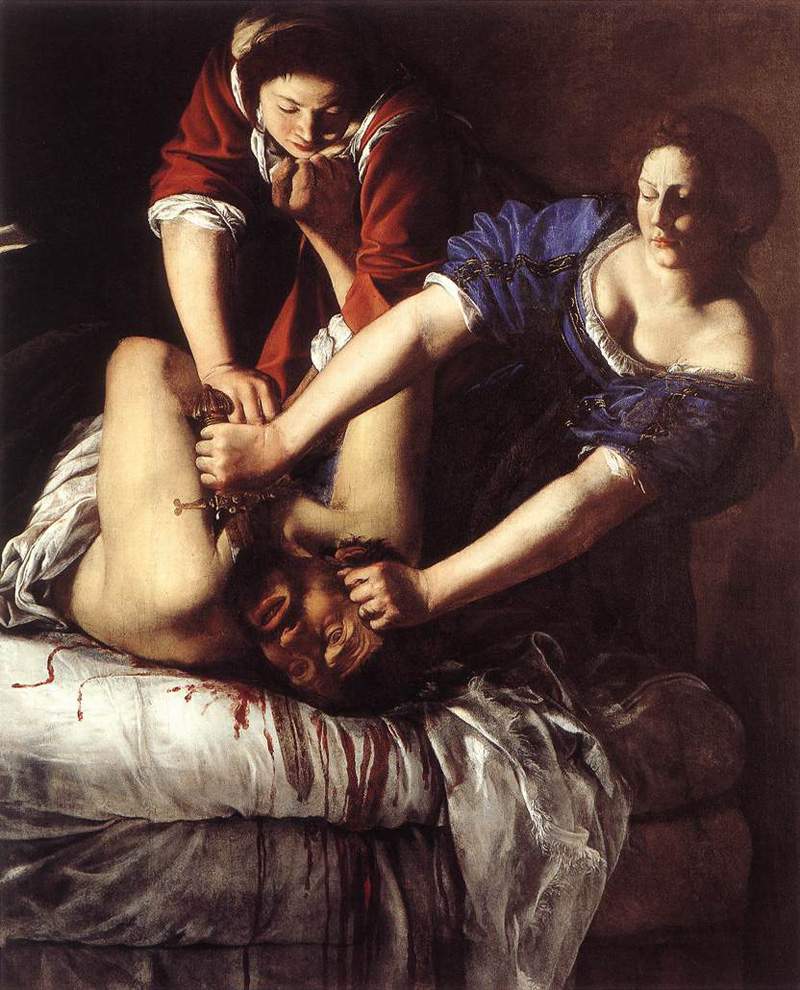 |
| Artemisia Gentileschi, Judith Beheading Holofernes (1617; oil on canvas, 158.8 x 125.5 cm; Naples, Museo Nazionale di Capodimonte) |
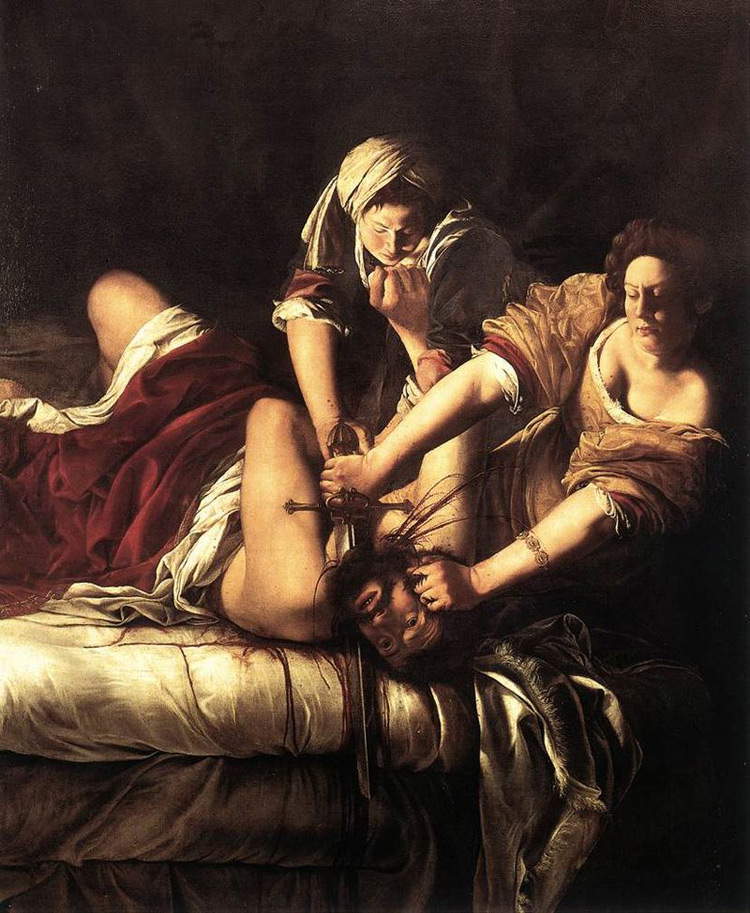 |
| Artemisia Gentileschi, Judith Decapitates H olofernes (1620-1621; oil on canvas, 146.5 x 108 cm; Florence, Uffizi) |
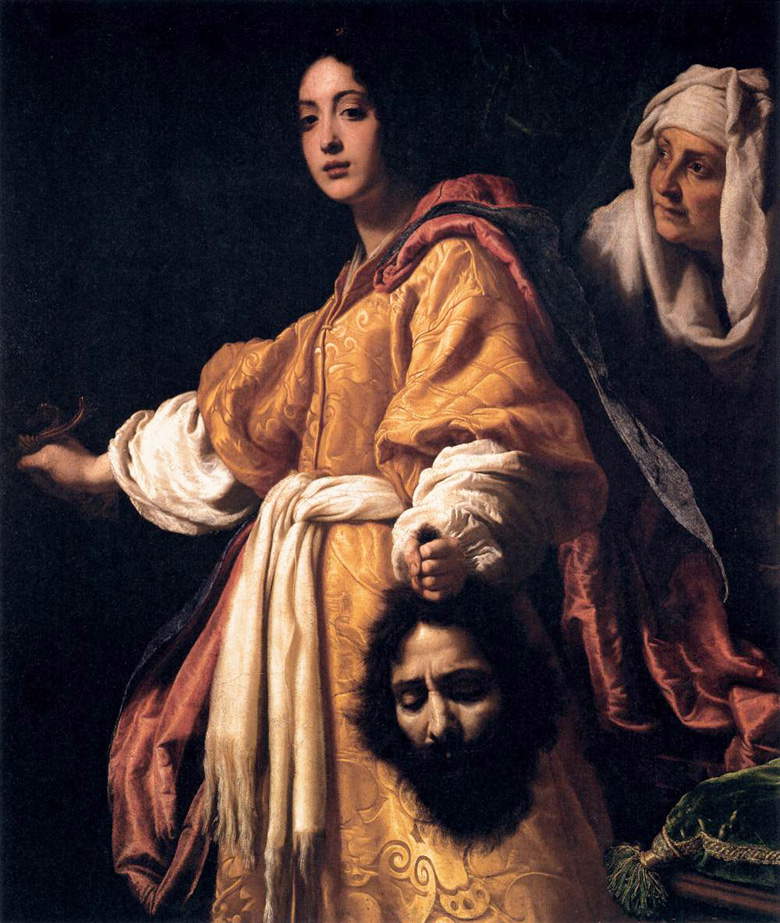 |
| Cristofano Allori, Judith with the Head of Holofernes (1610-1612; oil on canvas, 139 x 116 cm; Florence, Palazzo Pitti, Galleria Palatina) |
That vivid chromaticism characteristic of Cristofano Allori is strongly exemplified in a painting of his made in 1620, preserved in the Uffizi Galleries. The theme depicted is still the biblical episode of Judith and Holofernes: the scene depicts the maiden who has just beheaded the general and proudly shows the viewer her trophy. Holofernes’ severed head in fact dangles from the heroine’s left hand, which holds it only by a tuft of hair in the central part of the head. Holofernes’ eyes are closed, his mouth is half-open, and his entire face is surrounded by thick hair and beard. Judith is placed in the foreground, in the center of the scene, and next to her we catch a glimpse of the face of her trusted handmaiden Abra, who in this work is depicted as an old woman, whose head is wrapped in a broad, soft turban. What strikes the viewer, however, is Judith’s dress, which Allori painted and decorated paying attention to the smallest details in the rendering of the various fabrics and in the choice of colors: bright yellow for the damask dress, blue and red for the long cloak that, starting at the nape of her neck, descends softly down her back, and white for the wide sleeves of the robe underneath and for the sash tied tightly around her waist. The surroundings are also richly set up: a green curtain can be seen in the background, the same color as an elegant cushion peeking out from the lower right corner of the painting.
It is thus clear that, during the seventeenth century, the biblical theme of Judith and Holofernes was represented recurrently: many artists chose it as the subject of their paintings, each following their own compositional, decorative, and chromatic modes. Artemisia Gentileschi was more than any other artist approached with this theme as a vindication of women over the abuses of men, but in reality she followed one of the fashions of the period, if we can call it that, nevertheless personalizing it with her own style, passion and drama.
Reference bibliography
Warning: the translation into English of the original Italian article was created using automatic tools. We undertake to review all articles, but we do not guarantee the total absence of inaccuracies in the translation due to the program. You can find the original by clicking on the ITA button. If you find any mistake,please contact us.